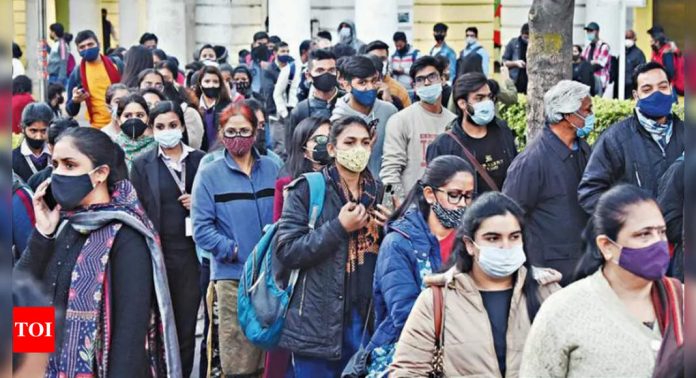NEW DELHI: The queues and waiting times to enter a subway station, which are sometimes longer than the journey itself, were back in Delhi on Wednesday, along with massive crowds at bus stops during rush hour as a level 1 of the Covid Graded Response Action Plans (GRAP) have been imposed.
Although the Delhi Metro Rail Corporation (DMRC) began following instructions from the Delhi Disaster Management Authority to impose the yellow tier of GRAP on Tuesday, its real impact on the carrying capacity of the metro was not visible until Wednesday morning.
As part of the curbs, the Delhi Metro and local public transport buses were allowed to travel with 50% of their seating capacity and with no standing passengers. Para-transit like cars, taxis, e-rickshaws, and Gramin Sewas can only carry two passengers at a time.
In order to regulate the number of passengers in stations and trains in order to ensure behavior in accordance with Covid, DMRC only kept 444 of a total of 712 gates in the network open. It has also urged passengers to travel only when strictly necessary and allow extra time for the trip. The DMRC has deployed 15 flight crews to ensure that the safety protocol is followed.
There were huge lines to enter stations like Laxmi Nagar, Akshardham and Mansarovar Garden in East Delhi and Saket and Chhatarpur in South Delhi. DMRC had to temporarily close the entrance to some train stations in order to regulate the number of passengers inside.
“What use is it to keep a distance of two meters within stations if we have to wait so long to enter one, and usually without keeping a lot of distance in the queues outside. These restrictions may be for our safety, but only lead to chaos and nuisance for passengers, ”said Kamal Sharma, a resident of Mayur Vihar.
Busy bus stops were more chaotic during rush hour. Commuters had to wait a long time for buses that seemed elusive and noisy to get on when one arrived. “Not everyone has the luxury of working from home, and since private offices have been allowed to open, people like me have no choice but to go to work. I can’t afford the metro and buses only allow very few passengers, ”said Rajesh Pal, a resident of Kapashera.
Amit Bhatt, Executive Director (Integrated Transport) at WRI India said that something should be done now to reduce the demand for public transport and encourage more people to work remotely without those whose job requires it to be in the field. “Based on global experience, there is no empirical study that suggests that public transport contributed to the spread of Covid,” he said.
Anumita Roychowdhury, executive director of research and advocacy at the Center for Science and Environment, also said unnecessary travel should be discouraged but temporary measures should be taken to expand services.
She also said there are restrictions from insufficient services and it cannot be fixed overnight, but short-term action needs to be taken first. “Immediate action should be how many more buses the government can bring in from various sources, just as they did during the pollution emergency. They can also step up the service by increasing the number of trips, ”she added.

